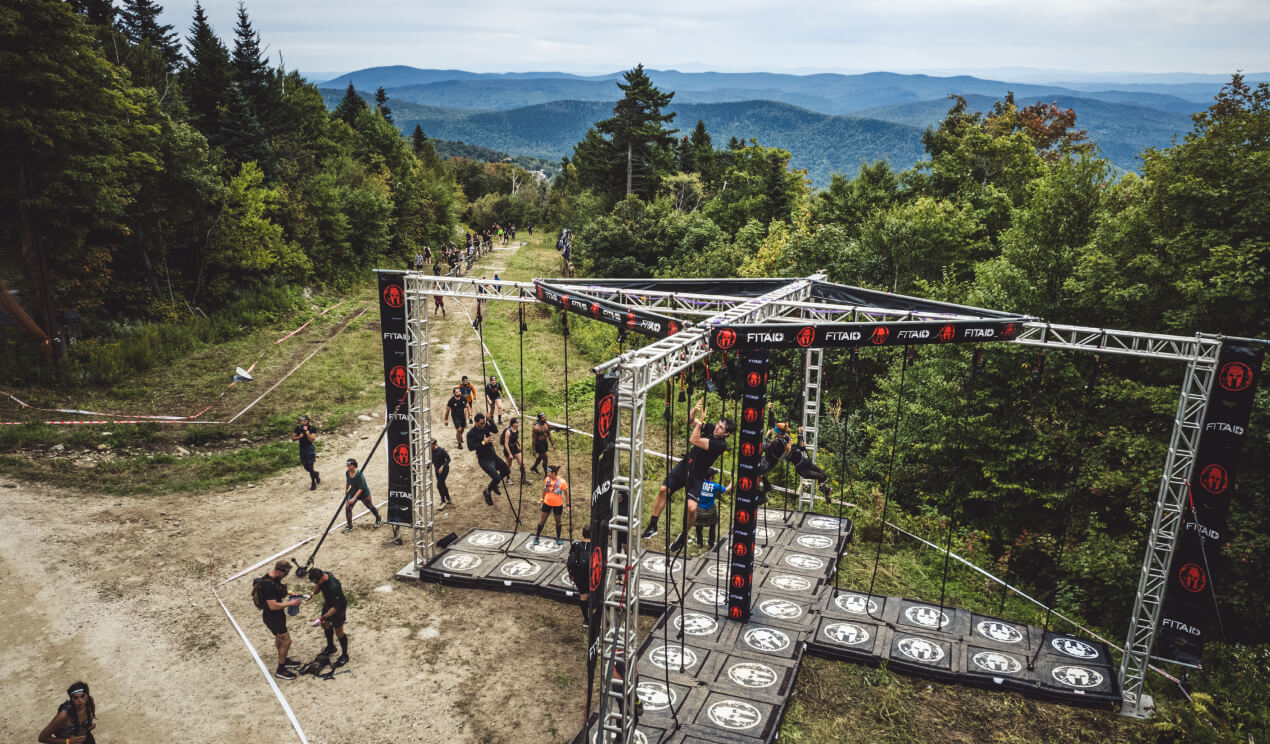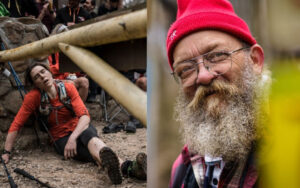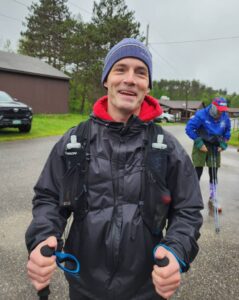
The Killington Beast is brutal. It’s not like other Beasts, and certainly not like any other Spartans at all. It’s completely unique in its climbing, not just in terms of elevation but in the repetitive steepness of the climbs. Success often comes down to three things: Your ability to be on your feet for a long time, your ability to do lots of steep uphills AND downhills, and your ability to do lots of slow, boring burpees.
Common Training Mistakes:
- FOCUSING TOO MUCH ON OBSTACLE PREP: Honestly, obstacle proficiency won’t matter a whole lot in this event. I’ve seen people spend so much time and effort trying to get something like monkey bars in the months leading up to the event, and then be so wiped out from the course when they get to the monkey bars that it doesn’t matter. They can’t do them. Or the bars are already caked with mud and water from other racers. So even if you can do obstacles while fresh in the gym, if you’re not conditioned for the course, it won’t matter. The time is better spent prepping for the terrain and time on feet.
- THINKING ALL ELEVATION IS THE SAME: I had a client I used to train for Killington who I would tell to go to a nearby steep ski hill and do repeats. Instead, he would do long runs elsewhere and show me how much elevation he got. And I’d yank my hair out. I don’t care about elevation on a run. Not all elevation is the same. You need to recreate/simulate the experience. The course is steep, repetitive climbs and descents. You have to do that to prepare.
- NOT CONSIDERING THE DETAILS: On such a long course, you can get all the physical training right, and then be done in by details like dehydration, poor nutrition, or gear problems. You might be out there anywhere from 7 to 13 hours. Your hydration/electrolyte intake needs to be on point, you need to have enough food and some real food to fuel you, and you need to test it out beforehand so you know what doesn’t bother your stomach. You also don’t want to find out halfway through that your pack is rubbing your torso raw or your socks/shoes are causing blisters on your feet. So these things need to be simulated ahead of time and are as important as the physical training.
TRAINING TIPS
- LOTS OF STEEP CLIMBS AND DESCENTS: The bulk of the course is long uphills and downhills on steep ski slopes. So that’s where most of your training should be focused. So go to the biggest, steepest hill in your area and do that repetitively. Don’t worry so much about speed on the uphills. Those are meant to be endured. Descents are especially important here. People always focus on the climbing part and neglect the downhills. Even when the wheels come off during the race, you can still take slow steps uphill. But when the wheels come off on the downhills, every step becomes excruciatingly painful. That’s what ruins most racers. The pain of stabilizing downhill. Building up downhill endurance on steep slopes is the most important thing you can do here.
- TIME ON FEET: People get too focused on training mileage when training for something like this. So much of this course is a painful, slow slog. When training steep climbs, your mileage isn’t going to be huge. That’s okay. It’s more about the time you spend on your feet training than it is about the miles you accumulate. So focus more on hours than miles.
- DO LOTS OF BURPEES: People get psyched-out by the thought of burpees and focus so much on training for obstacles so they can avoid them once or twice, only to slip on an obstacle or be cooked anyway. You want to bulletproof yourself against this so that if things don’t go ideally on the obstacles, it won’t sabotage you and won’t rattle you. You want to be able to chew up burpees and have confidence about them. So, obviously, do lots of burpees in your training. But also remember burpees don’t have to be fast, not in training and not on the course. They just have to be endured. So if you fail an obstacle, it doesn’t matter if it takes you 10 minutes to do all 30 burpees. Do one, shake it out, do another, shake it out. Whatever it takes to get through and march on.
- LONG, HEAVY CARRIES: Train for long, uncomfortable, heavy carries. Carry heavy stuff around the building or complex for what seems obnoxiously long times. Long enough that you have to put them down multiple times along the way. It’s also good to incorporate some heavy carries at the hill, because they will have you carry uphill at the race. Do something like wreck backs, buckets, dumbbells, a rock. Something uncomfortable. TIP: Don’t start too big, too quickly. Just one or two hill laps with carry during a session.
- DETAILS & LONG SESSIONS: As I mentioned earlier, equipment and nutrition details show up during a long race. Prepare by simulating some long sessions before the race. Wear your hydration pack not just on long sessions, but also regular training at the hill to see if problems arise like friction points or if you struggle to get the water out or it isn’t enough storage. Practice drinking what you’re going to drink and eating what you’re going to eat during these times to see if stomach problems arise. Make sure you’re fueling properly to keep your energy up. Wear the socks and shoes you plan to wear to see if your feet rub or blisters occur. Skyline hikes at Blue Hills are good prep, as are repeated loops someplace and, of course, just spending a long, long time doing repeats at the hill. (FYI: I’m actually eyeballing the morning of Saturday, June 29 for an extended training session at Big Blue to simulate an event I’m considering the next month.)
- BODY GLIDE/LUBE: Practice using body glide/lube prior to the race to see if you have any skin irritations. Things that don’t pop up in four or six hours start popping up when you get to eight or 10. That is friction points where your pack rubs against your back, shoe tops rub your ankles, your arms rub your sides while running, your shirt can rub your nipples and make them bleed, your butt cheeks and various other body parts rub and get irritated. Ah, welcome to the glamorous world of endurance races!!! These seem funny to talk about, but they become very real, very terrible issues deep in a race. Make sure to lube up EVERYTHING ahead of time – all the friction points, your feet, butt cheeks, other parts, and it’s good to keep a small Body Glide on you during the race.
- STRATEGY: Don’t come out of the gate too fast. Everybody plans on taking it slow to start, but then once the race begins, they get caught up in the adrenaline. Take it easy, especially on the hill climbs. Don’t go at a pace where you feel you’re exerting yourself at all. This is the hardest thing to do sometimes. Hold back the first half of the race. The exerting will come the second half when you feel broken and need to exert yourself just to keep moving forward.
ONE LAST THING: Perhaps the most important part of these long, grueling, painful events is the mental side of it. Unfortunately, that’s almost impossible to truly simulate and prepare for ahead of time. Sure, you can put yourself through long, difficult training sessions that you don’t want to do but make yourself do anyway, and that will certainly help. But there’s nothing like the lows you encounter in a race. Honestly, most of the growth in this area comes from just doing races, struggling or coming up short of expectations, reflecting later on on those moments and considering what you could do or think differently, and then bringing that knowledge and experience to that moment the next time you’re doing a race.
But there’s a few things you should tuck in the back of your mind to tap into during the race. Remember that success isn’t about those moments when you’re feeling good or kicking ass. It’s about when you feel low and beaten and don’t care anymore about finishing and just want it to be over. That’s when the race really happens, and then it comes down to just slowly putting one foot in front of the other. Nothing glamorous. Feeling like a failure, but still moving forward. The mind plays a lot of tricks. It tells you you’re done, it makes you feel exhausted, and it judges you. Thoughts creep in that are really judgemental, that say you don’t belong or that you’re a failure or that you should just quit. Those thoughts will be there and, unfortunately, you can’t make them go away. Do this stuff long enough and you learn it isn’t about making them go away; it’s about creating other voices or mantras or thoughts that counterbalance that stuff. That allow you to just keep marching forward. Shut off your mind as much as possible and just march forward one step at a time for hours on end if need be. That’s the true race.
Also, it doesn’t always get worse. No matter how bad you feel, no matter how much your tank is at empty, give it time and often things come back. It’s surprising, but it happens. Stay in the game and you find that second, third, fifth wind. Often you just get something to eat or stay slow long enough that the energy comes back. Just stay in the game.


